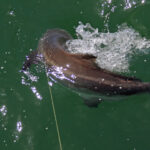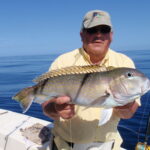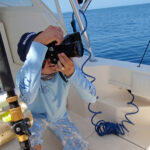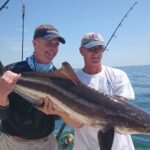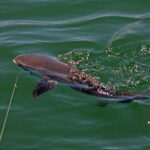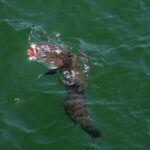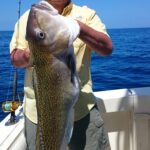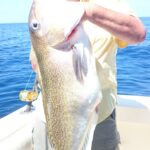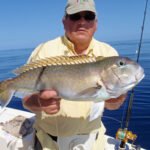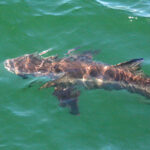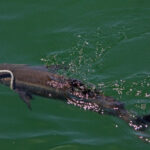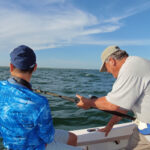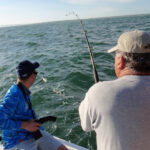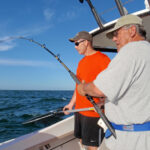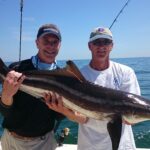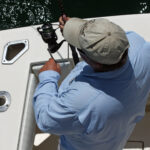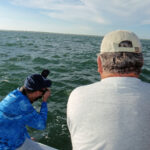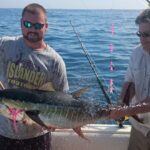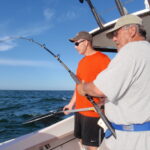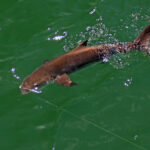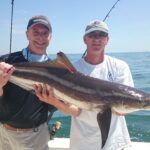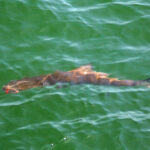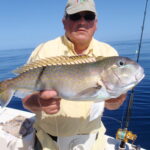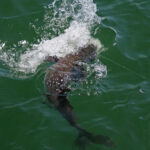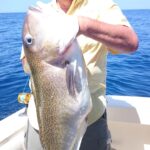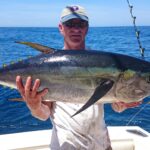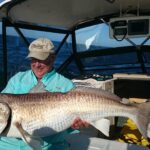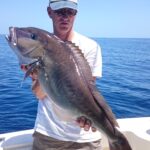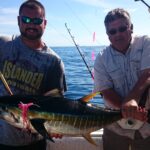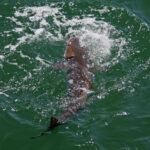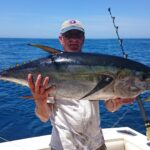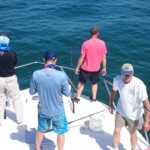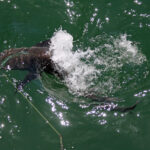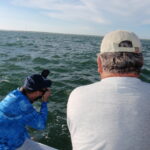Fishing Inshore and Offshore Virginia Beach
A long early-summer weekend out of Virginia Beach highlights fishing opportunities in and offshore of Chesapeake Bay.
By Sam Hudson
Sport Fishing Magazine
April 2016
http://www.sportfishingmag.com/fishing-inshore-and-offshore-virginia-beach
An Embarrassment of Riches
 Tim Rudziensky / virginiaphotoart.com
Tim Rudziensky / virginiaphotoart.com
Most trips for Virginia Beach anglers start at Rudee Inlet. The 110-foot-wide channel allows access to offshore canyons and nearby Chesapeake Bay.
Leaving Rudee Inlet well past noon on a late-May day, I couldn’t wait to target some of the baddest bull redfish on the planet. Charles Southall idled out of the slow zone, then powered north past the last straggling jetty rocks. His 24 Albemarle took the pesky swells soundly, making use of the length and beam to handle the snot. I was in good company, fishing with members of the Peninsula Salt Water Sport Fisherman’s Association (pswsfa.com), an active group of recreational anglers. Southall, Ken Neill and Stan Simmerman were my guides to finding and hooking the giant red drum that guard the mouth of Chesapeake Bay. Spots east of the Chesapeake Bay Bridge-Tunnel attract huge drum, both black and red, and cobia in the summer among scattered shoals.
Over the following days, we sampled the inshore and offshore fisheries available to fishermen leaving from Virginia Beach. I quickly realized the area’s fish-catching potential. Neill explained the excellent fishing by pointing out that many popular fish species from the upper Atlantic, such as striped bass, tautog and bluefin tuna, head south to Virginia Beach in colder weather, while lower-Atlantic species like speckled seatrout, cobia and redfish are available in the warmer months. These species together, mixed with common mid-Atlantic species, give Virginia Beach an exceptional diversity of sport and food fish throughout the year.
Reds in the Washing Machine
 Sam Hudson
Sam Hudson
When the bite’s hot at the mouth of the Chesapeake, someone has to put down his rod and grab a net. Charles Southall nets Stan Simmerman’s bull red drum, with Ken Neill’s fish next in line.
Simmerman’s goal during the trip was to land a Virginia citation red drum, and I wanted to see it happen. I didn’t know what “citation” actually meant at the time, but figured it likely involved catching an absurdly large redfish.
Here’s the scoop: Each year, local anglers take part in the Virginia Saltwater Fishing Tournament (mrc.virginia.gov/vswft). When an angler with a valid Virginia fishing license catches an eligible species, he or she measures or weighs it. Fish that surpass a minimum threshold are then recorded on an official entry form. Some eligible species are released because law requires it; others, such as tuna, tilefish or cobia, can be kept because they’re legal to harvest and delicious to eat. Lastly, an approved citation is sent to the angler in recognition of his or her trophy catch. The event, put on by the Virginia Marine Resources Commission, is funded with marine recreational-fishing-license dollars. Citations are fun milestones for anglers to achieve, but also serve to recognize trophy catches without killing protected fish. Six different citations in a single year earn a fisherman expert angler status.
Simmerman’s citation ambitions meant he had to land a red drum measuring at least 46 inches. We set the anchor in green-water washing-machine conditions outside a span of bridge-tunnel near buoys 8 and 10. Today wasn’t the day for a Hopkins Hammer spoon or feathered jig, which are often trolled or cast in the area. Instead, Southall and Neill pulled out Shimano TLD 15s and then rigged blue crabs, peeler crabs and chunks of clam on fish-finder rigs. In total, seven different setups, with sinkers weighing 6 to 10 ounces, filled out the lineup.
“In the early part of the year, the redfish are north of here, at the inlet between Fishermans Island and Smith Island,” said Southall. “But today we’re fishing in about 15 feet, with 8 feet on one side and 25 feet on the other. This whole area is filled with bars and troughs.”
 Sam Hudson
Sam Hudson
No puppy drum here. Southall’s full-size drum hit a whole crab hooked to a fish-finder rig. The shifting channels and currents at the Bay Bridge-Tunnel require heavy sinkers and tackle.
The evening bite turned on with the tidal change. Southall’s clam chum slick attracted plenty of attention behind the boat. First, tire-size eagle rays found the shellfish meant for black drum. Soon the reds found the crabs. Neill hooked up to a solid red drum as he and Southall reset baits. “Get those baits out!” Neill yelled. “They’re right behind the boat!”
That’s when the action really turned on. Nearby, anglers gaffed a cobia. At one point, Simmerman, Southall and Neill hooked up simultaneously. In total, the boat released eight reds in a span of a couple of evening hours. All were over the size limit, some as long as 46 inches, though Simmerman never landed his citation. Neill points out that red drum fishing is excellent from May all the way into October in the Chesapeake.
Norfolk Canyon Wild Card
 Sam Hudson
Sam Hudson
Norfolk Canyon is a main attraction off Virginia Beach, attracting pilot whales, porpoises, and fishermen intent on trolling up tuna and billfish.
We spent two days offshore of Virginia Beach targeting bigeye and yellowfin tuna, with side action from tilefish to (literally) add flavor. A friendly network of anglers and captains, many connected with the Virginia Beach Fishing Center, clued Neill in on recent bigeye bites, narrowing our destination to depths of 115 fathoms in the Norfolk Canyon. We set out in pitch black in Neill’s Classic Carolina 35, Healthy Grin, at 2:30 one morning, joined by local anglers Wes Blow, Gabe Sava and Hunter Southall. At the grounds before first light, Sava and Southall set out a spread of eight rods and two teasers, mostly a mix of Shimano Tiagra 80s and 50s. The entire spread consisted of two flats, two shorts with larger baits, two longs, one shotgun, and a green squid behind a teaser. Jets, bullets and chuggers were all used, mostly paired with fresh ballyhoo, bluefish or Spanish mackerel.
And even with that healthy spread, the bigeye (minimum citation weight 70 pounds) never showed. At one point, we trolled through lively pods of pilot whales and porpoises that spread across acres. No tuna of any color were with them, though the display of power and nature was stunning.
 Sam Hudson
Sam Hudson
Wes Blow lands a quality blueline tilefish in 50 fathoms.
Rather than wasting time on a slow bite, Neill headed toward the tilefish grounds. “The bite from bluelines (citation minimum 10 pounds) and goldens (citation minimum 30 pounds) is excellent all year,” said Neill. That’s if conditions allow the 60-mile run out to the tilefish grounds. We dropped two-hook rigs with 9/0 live-bait hooks and 24 ounces of lead all the way to the bottom in 600 feet. Strip baits included squid, dolphin and cobia bellies, and chunks of bluefish.
With each bite — and there were plenty — I had no idea what to expect. The only species I recognized were cod and tilefish. Those fish that Neill had to ID for me included blackbelly rosefish (related to rockfishes of the Pacific Coast), hake, conger eel, spinycheek scorpionfish and a spiny dogfish. Simmerman landed a 30-plus-pound golden tilefish that met citation requirements, while Blow landed his own citation blueline tilefish, weighing 18 pounds, at the 50-fathom mark. If we’d fished shallower, I’m certain we could have hooked tautog (citation size 9 pounds) and black sea bass (citation 5 pounds) at inshore wrecks.
 Sam Hudson
Sam Hudson
Yellowfin tuna school up thick in May and June off Virginia Beach. Southall shows off an average-size fish caught while trolling.
No matter what we targeted, the fish in and around Virginia Beach always seemed to be bruisers. I saw further evidence of that the next day offshore, targeting yellowfin tuna (citation 70 pounds). Trolling by the nearest weather buoy, we picked up two mahi before running out to 480 fathoms. At the grounds, 14 sport-fish boats, including some from Oregon Inlet, North Carolina, weaved and trolled among a massive pile of yellowfin tuna. I can describe the scene only as organized chaos, but everyone agreed we’d found the mother lode of 30- to 50-pounders.
Throughout the morning, numerous boats hooked up simultaneously, and I watched many of the charters quickly fill limits for their customers. Our boat landed 11 yellowfin tuna before we started running out of ice. Since the fish were actively surfing the swells, Wes Blow pulled out a medium spinning setup and cast out a Sebile Stick Shadd.
Almost immediately, a tuna broke from the surface pack and slammed his lure. (Sava and I had cast our arms off earlier that morning with nothing to show for it.) Blow battled the yellowfin for the next hour, pulling it back to the boat with a rod that lacked critical backbone. I was especially happy after he finally cranked the fish to the surface and Hunter Southall gaffed it. Just minutes before Blow cast to the tuna, I had shown the guys how to tie an FG knot; in fact, it was my first time tying the knot on the water, and I was relieved the fish hadn’t broken off because of a knot failure!
Chesapeake’s Prevalent Cobia
 Sam Hudson
Sam Hudson
Rob Wittman’s healthy cobia was tagged by Wes Blow (right) before its release. Cobia invade the interior waters of Chesapeake Bay in summertime, offering exceptional sight-fishing.
Great numbers of cobia (citation 55 pounds) take over Chesapeake Bay each June through September, to the delight of light-tackle anglers. “I’ve noticed that specialized sight-fishing charters for cobia have really taken off in the bay in the last couple of years,” said Neill.
Passing underneath the bridge-tunnel on the morning between our offshore days, all anglers aboard Neill’s Carolina Classic started searching for cobia along the Baltimore Channel (sometimes marked as the Chesapeake Channel on maps). Neill positioned his boat up and down the channel all morning, like a Roomba cleaning a kitchen floor.
“Generally, you won’t see anglers looking for cobia inside the bay past the entrance to the York River,” he explained.
Fishing with us was Rob Wittman, U.S. congressman, of Virginia, who has an obvious passion for cobia fishing. Heck, his personalized license plate reads “COBIA.”
Almost immediately we saw a cobia, so quickly that no one was actually rigged and ready. Eventually Southall popped out a live eel, Neill launched a Reel Fast Tackle cobia jig, and Wittman cast an emu-feather Meat Hog jig with a squid-head design. We weren’t ready for that fish, but 15 more ling popped up that morning.
“I’ll anchor in my boat at specific spots along channels or buoy markers and chum for cobia too,” mentioned Blow. This technique is in direct contrast to sight-fishing. “You’ll catch some sharks, but it’s an unbelievably effective way to catch cobia in the bay. Chum with fresh or frozen menhaden, but the cobia bites always come on live eels at the bottom.”
 Sam Hudson
Sam Hudson
Top baits include jigs and live eels.
Wittman made a pinpoint cast to successfully tempt a nice cobia off the bow. He probably hooked more cobia than anyone throughout the day, and his excitement was obvious after each bite. At the stern, Blow tagged and released the cobia as part of the Virginia Game Fish Tagging program. He and other members of the Peninsula Salt Water Sport Fisherman’s Association take fishery science seriously, tagging many fish they don’t keep and submitting some carcasses of the fish they do eat to the Virginia Marine Sportfish Collection Project.
One estimated 45-pounder was tagged before its release. That prompted Sava and Southall to call out: “Hey! That was dinner!” Neill changed that empty-plate scenario pretty quickly. While I took photos of a different cobia, a larger fish popped up on the starboard side and Neill made a cast from the tower. “I was hooked up before anyone even saw it,” he said, “ and I slipped that fish into the box before Wes got to it.”
Over one four-day weekend, I experienced Virginia Beach’s exceptional fishing thanks to die-hard anglers at the Peninsula Salt Water Sport Fisherman’s Association. What’s more, just weeks after my trip, Neill and crew had successful June trips for bigeye tuna, white marlin and tautog. Virginia Beach’s embarrassment of riches for saltwater anglers might be its most enduring attraction. The waters in and around Chesapeake Bay and Rudee Inlet should be on everyone’s radar.
A Missed Opportunity
The one popular species that I never saw during my trip was white marlin, available in high numbers from August to September and decent numbers from June to October. I was a little early to experience this exceptional fishery off Virginia Beach.
Neill had a series of trips in September 2015 when his boat averaged five to eight fish a day.
“We were actually helping with two projects done at Dr. John Graves’ lab at the Virginia Institute of Marine Science,” Neill explained. “White marlin are considered a single stock, but with the bite going off Virginia, Venezuela and other locations at the same time, there may be separate stocks that should be managed separately.”
Neill and his crew helped collect DNA samples via fin clips to allow scientists to compare molecular genetics — and they had fun fishing while doing it. Graves also wanted to deploy pop-up satellite tags on specific fish to understand how removing fish from the water affects post-release survival.
Neill recounted an overnight trip in September at Norfolk Canyon: “While trolling for marlin, we put out a small spoon to try for young-of-the-year bluefin tuna, but only landed blackfin, skipjack and frigate tunas. We put them out as bait during the night, landing a swordfish and some impressive sharks. The following day, we caught eight white marlin, snipped a DNA sample from each, and released each with a satellite tag.”
 Chris McGlinchy
Chris McGlinchy
Virginia Beach Species Availability
Easy Access to the Beach
 Sam Hudson
Sam Hudson
Fishing can be hot for specific species such as red drum all year long.
Planning a fishing trip to Virginia Beach is a breeze.
First, book a connecting or direct flight to Norfolk International Airport. Once you’re there, a car rental, place to stay, and a couple of charter days out of Rudee Inlet are all that’s left. The Virginia Beach Convention & Visitors Bureau (visitvirginiabeach.com) booked my stay at the Comfort Inn & Suites Virginia Beach (757-425-8200). Just a 25-minute drive from the airport, I was perfectly situated on the beach, with a close walk to the Virginia Beach Fishing Pier.
To get to the docks at Rudee Inlet Marina, I had a five-minute drive to Winston Salem Avenue, where a host of top charter companies harbor their boats. Neill and Southall docked their boats there for the weekend, allowing easy access to the inlet each morning.
Call the marina (757-422-2999) to see what’s biting or check the chart on page 42. Fishing can be hot for specific species all year long. This past December and January — in the belly of winter — Ken Neill sent me solid reports and pictures of yellowfin tuna, sea bass and tautog catches. I can’t say I wasn’t jealous.

